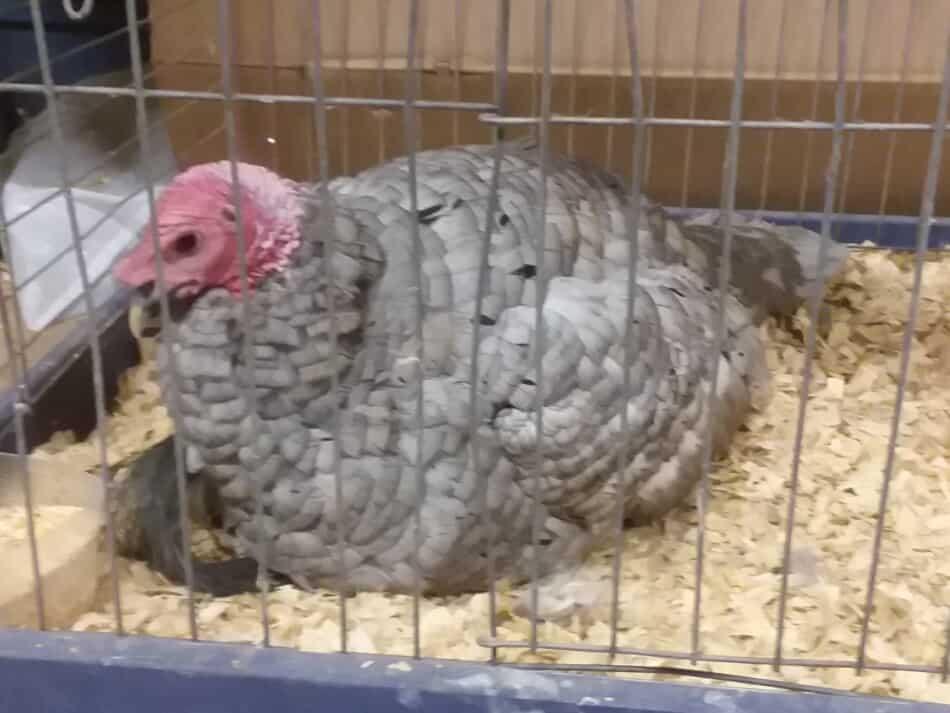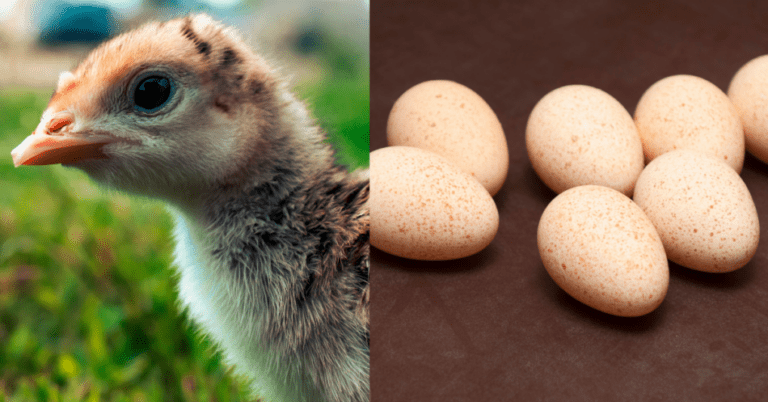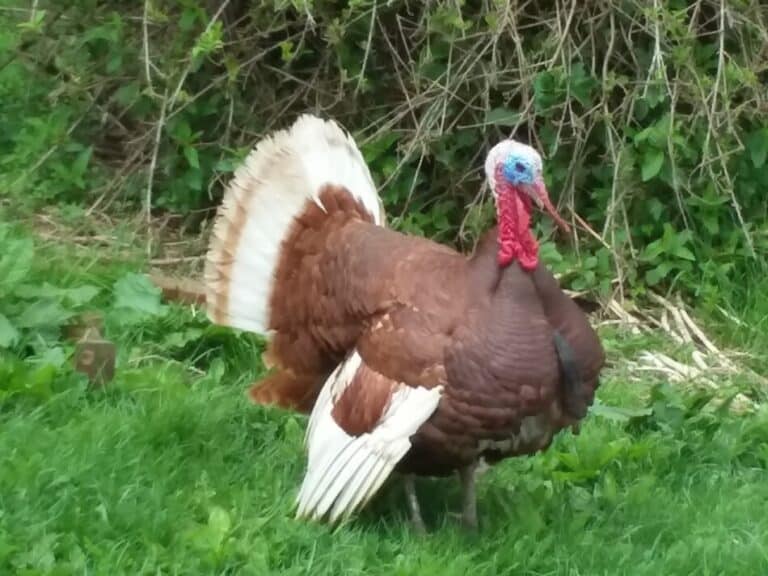How To Tell The Difference Between Male And Female Turkeys

Male and female turkeys are sold straight run, meaning the males and females are all together in the “as hatched” ratio.
As they grow, turkeys have the same markings in both sexes, unlike other poultry where the older males seem to have a more bold color pattern.
Since turkeys look very similar, no matter the age, how do you tell the male turkeys from the females?
Male turkey poults will develop a snood sooner than the females. Male turkeys will weigh more, continue to grow faster than the females, have a more caruncled head and neck and, as adults, will develop a beard. Female turkeys look like less developed males, with less body size, less caruncled skin on the head and neck and do not have a beard.
If you are interested in the differences between breeds of turkeys, read my article 10 Breeds Of Turkeys For Raising Your Own Meat.
As adults, male turkeys are bigger
As adults, male turkeys, called toms, are always bigger than females, called hens. This is the easiest way to tell the sexes apart at a glance, simply note the body size.
When the poults are growing, this size difference by sex is noticeable, as well, it’s just easiest to see in adults.
Male turkeys have a beard and more caruncled head and neck
When you look a bit closer at adult turkeys you can see that the males have a few physical characteristics that set them apart from the females.
Adult male turkeys have a beard that is more of a tassel of coarse hair on the front of the chest. I have only seen the beard to be black and hens do not ever grow a beard.
The Blue Slate turkey pictured at the beginning of the article is a tom, if you look closely you can see the beard in the lower left hand corner.
With him sitting like this it’s hard to tell at first glance if this is a male or female, but as soon as you see the beard, you know this turkey is a male.
Male turkeys will also end up showing a much more caruncled head and neck than females. If you watch the toms, when they fluff up the caruncled areas that are normally red will turn blue, it’s quite the sight!
Both sexes of turkeys fluff and strutt, not just males
I have not seen it mentioned before (I’d guess it’s somewhere, I just haven’t run across it) that the hens can fluff up and strutt, just like the toms.
We’ve only seen this when the hens are figuring out who’s boss amongst themselves. Now that we only have one hen, I don’t see this anymore.
When we had multiple hens, they would poof up for each other. I figure this is a pecking order type display, but I don’t have any conformation on that.
Normally, when you are seeing a turkey fluff and strutt, it’s a male. The toms do this tons more often than the hens.
In a larger sized flock of turkeys, if you see a group of unusually small “toms” fluffing and strutting for each other, especially if that peer group has significantly bigger toms, those smaller birds fluffing and strutting may actually be hens!

As poults, both male and females are very similar
It’s tough to tell the males from the females as poults. If they are day old poults, I’m not sure that you can, at least I don’t know a definitive way to do it.
Once the poults have age to them, even a few weeks, you should start to see some growth differences between them.
If getting males is super important to you, take a scale that is pretty sensitive and weigh them. The males will be heavier after a few days of eating. It won’t be much, but I’d guess the difference would show up by a week or so.
If you are just doing the selection by eye, you’ll need to pick the slightly bigger birds and keep a close look out for snood development to be more likely to get the males.
If you are selecting for female poults, do just the opposite. You’ll want the smaller ones that have little to no snood development.
Never pick a poor doer or an unhealthy looking poult. If you notice that some of the poults don’t look so great, skip buying from this group. You want healthy poults only, never accept less.
Male poults will develop their snood sooner
The male poults will develop a noticeable snood sooner than females. The snood is that little fleshy bump that is sticking out of the top of the head where the beak meets the forehead.
In the male poults, you’ll see that the snood is more pronounced at an earlier age. The gals will catch up a bit in snood development, but never to the extent of the males.
To me, this is the easiest thing to spot for identifying male turkey poults. They do grow faster, but I have a hard time seeing that for sure, I tend to second guess myself! The snood starting to grow is more definitive to me.
Male turkey poults are bigger by 1 month of age
By the time your poults are one month of age or so you’ll be able to tell just by looking which ones are the males and which are females.
I’m always curious about what the hatching ratio is per batch but it really isn’t a big deal, since no matter what you are doing having both male and female turkeys will work out just fine.
Male turkey poults eat more feed per day than female poults
Here’s an article I wrote about How Much Feed Does It Take To Raise A Turkey? Check out the charts that show the feed needed by age for the poults.
You’ll see a huge difference in feed eaten per week and resulting weight of the birds. The reason this chart is significant is that it shows why the males are bigger than the females, they simply take in more feed per day so they gain more.
I always knew that there is a huge difference between toms and hens, even when they are being raised for meat birds, so headed to the processor before they are adults.
Until I put together this chart, I didn’t realize the reason why the males are able to gain so much faster. It’s really astonishing.
Raising unsexed turkeys for meat has advantages
Don’t let this “hens gain less than tom”s thing shy you away from buying and raising straight run (unsexed) turkeys.
Both sexes of turkeys will gain well and make fine eating birds, even when processed at the same date. The hens will be smaller of course, but sometimes that is just what you are looking for.
We eat turkey more than just the holidays, and you should, too. The smaller carcasses from the hens give you great flavor of home grown turkey and add a nice alternative to chicken, without the huge amount of leftovers!
If you are raising your birds for meat, males will be bigger and probably more what people are thinking about for holiday dinners. A huge bird on the table is an impressive sight!
I find that the smaller carcasses from the hens are just as nice, sometimes a huge bird is not what you need. I appreciate the opportunity to choose bird size to fit our needs.
For breeding stock, you’ll want to raise more poults than you plan to keep
If you are raising turkeys as potential breeding stock, you’ll want multiple choices of both males and females to keep as your breeders.
This means getting more poults than the number of adult turkeys you plan to keep.
Raising more turkeys than you plan to keep gives you choices
If you are keeping a trio, two hens and one tom, I would get at least 6, but 10 would be better since 10 poults would give you more choices of which ones to keep for your trio.
If you are serious about breeding turkeys, you’ll want more than one tom and a few extra hens. Things happen and occasionally one of your birds will die or get snatched by a predator.
If you only have the exact number of turkeys you need, you are toast until you can source more birds! This is a precarious situation to be in. Adult turkeys are hard to find, especially when you need them the most.
Do yourself a favor and keep a few extra birds around to keep your breeding program going even when the unexpected happens.
There will be individual differences between turkeys in peer groups
Even in a peer group (birds of the same age), you’ll see differences among growth and structural characteristics, like wider bodied or breed appropriate markings that you’ll want to be able to select for.
If you only get the amount of turkeys as poults that you want to keep as adults, you are limiting yourself to what ever you get, that’s not a good idea.
Your breeders should be your best stock, to know that you need to have other turkeys to compare them too and pick the best from the group.
Here’s the link to our local hatchery’s turkey page. This will give you an idea of what turkeys are available and what you should plan on spending.
Note that turkeys have a shorter availability season than other birds like chickens, so plan to order earlier in the year.


